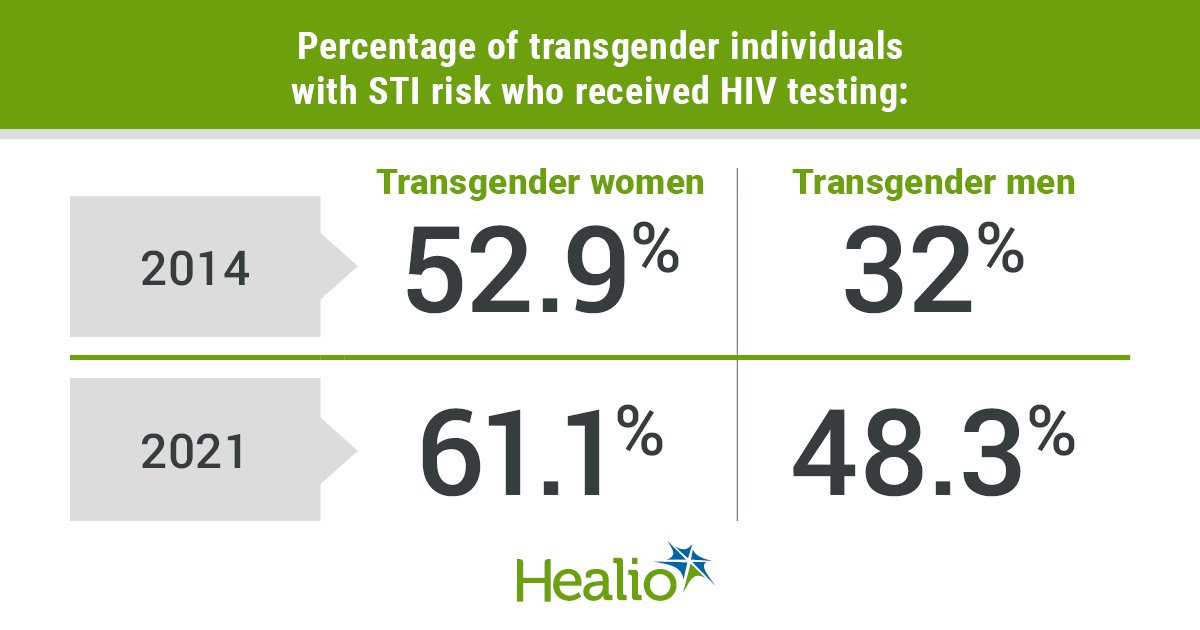
December 18, 2023
2 min read
Key takeaways:
- The proportion of transgender patients prescribed gender-affirming hormone therapy also rose.
- Clinicians can use encounters for gender-affirming hormone therapy as opportunities to discuss HIV prevention.
The prevalence of transgender-related diagnosis codes in the United States increased nearly ninefold from 2014 to 2021, with significant increases in HIV testing and pre-exposure prophylaxis prescriptions in this population, data show.
According to Ya-Lin A. Huang, PhD, MS, a health scientist at the CDC, and colleagues, pre-exposure prophylaxis (PrEP) offerings and HIV testing for transgender women and transgender men “are important components of comprehensive preventive health care.”

However, the researchers pointed out that PrEP use has been low among transgender people, despite them comprising 2% of new HIV cases in 2019, according to CDC data.
Thus, “it is important to monitor the use of HIV prevention services, including PrEP, by transgender persons,” they wrote in Annals of Internal Medicine.
The researchers analyzed 2014 to 2021 data from Merative MarketScan commercial databases to estimate the prevalence of prevention services among commercially insured transgender persons.
They found that the prevalence of transgender-related diagnosis codes increased from 13.4 to 113.9 per 100,000 enrolled persons. There was a substantial increase in the proportion of individuals who used gender-affirming hormone therapy (GAHT), which rose from 30.5% to 43.3%.
Additionally, of those with a transgender-related diagnosis code and GAHT prescription in 2021, 74.5% of transgender women and 25.5% of transgender men were prescribed feminizing and masculinizing GAHT, respectively. The trends were primarily driven by those aged 18 to 34 years, according to Huang and colleagues.
Meanwhile, the HIV testing rate in those at risk for a sexually transmitted infection (STI) increased from:
- 52.9% to 61.1% among transgender women; and
- 32% to 48.3% among transgender men.
PrEP prescriptions among those at risk for an STI and who received HIV testing also rose from:
- 1% to 20.2% among transgender women; and
- 0% to 10.2% among transgender men.
The researchers noted that the increase was likely due to a provision in the Affordable Care Act that “prohibits discrimination on the basis of race, color, national origin, age, disability, or sex.”
“In addition, over the study period, sociocultural changes resulted in increased acceptance of transgender and gender-diverse identities,” they wrote. “Health care providers will likely continue to see more patients seeking gender-transitional care and will need to be prepared to provide recommended care.”
Because the prevalence of clinical encounters for GAHT was higher than that of HIV testing, such encounters “may provide additional opportunities for HIV prevention services, such as HIV testing and PrEP” Huang and colleagues concluded.
References:
Sources/Disclosures
Collapse
Disclosures:
Huang reports no relevant financial disclosures. Please see the study for all other authors’ relevant financial disclosures.



